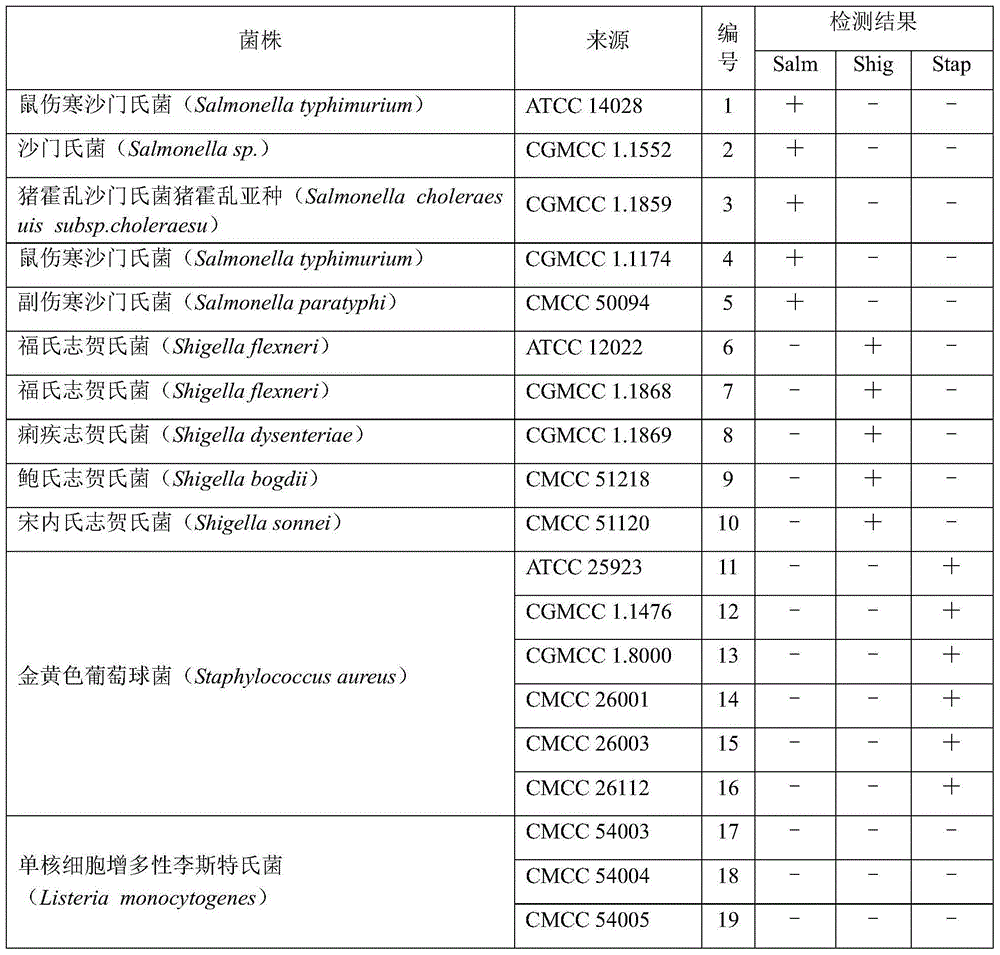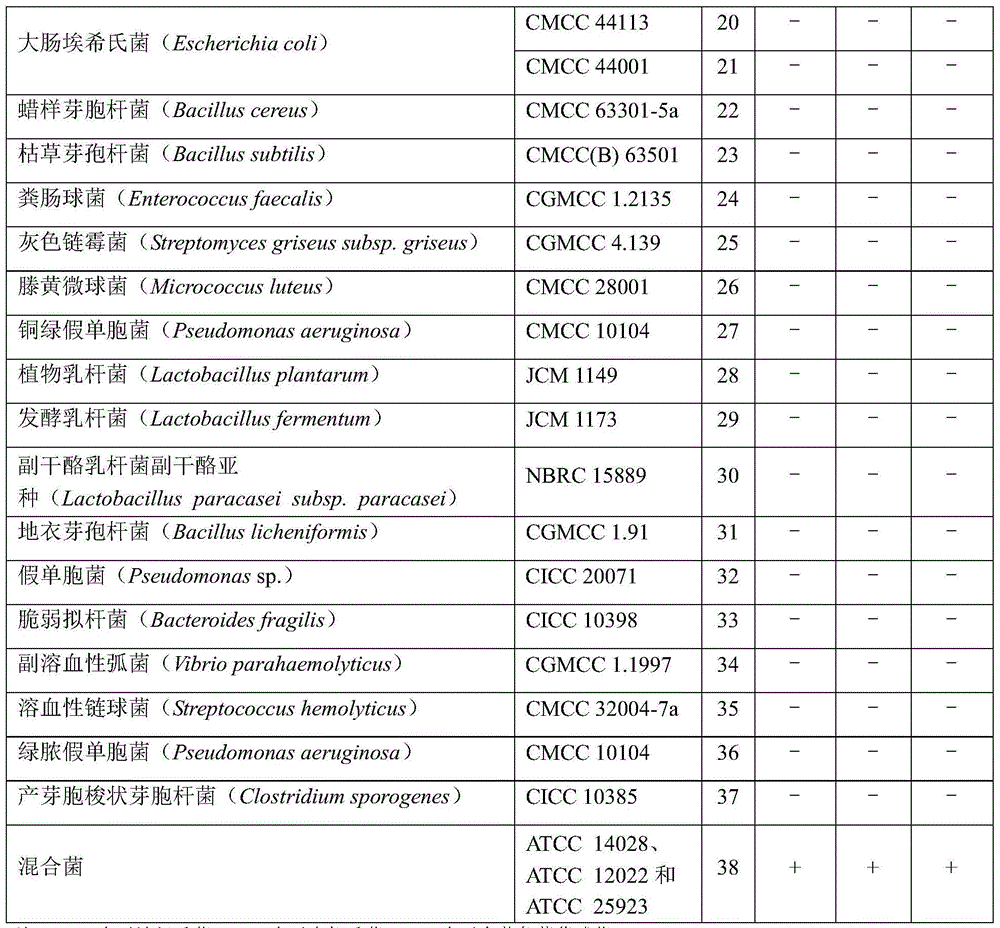Method of detecting salmonella, shigella and staphylococcus aureus
A technology of Shigella and Salmonella, applied in biochemical equipment and methods, measurement/testing of microorganisms, resistance to vector-borne diseases, etc., can solve the problem of low sensitivity and accuracy, difficulty in simultaneous detection of three strains, etc. problems, to achieve accurate results, improve rapid response, and high sensitivity
- Summary
- Abstract
- Description
- Claims
- Application Information
AI Technical Summary
Problems solved by technology
Method used
Image
Examples
Embodiment approach
[0040] According to a preferred embodiment of the present invention, the specific fluorescent probe 1 can be SEQ ID NO: 7 with FAM connected to the 5' end and BHQ1 connected to the 3' end, and the specific fluorescent probe 2 can be CY3 connected to the 5' end And the 3' end is connected with SEQ ID NO: 8 of BHQ1, and the specific fluorescent probe 3 can be SEQ ID NO: 9 with the 5' end connected with CY5 and the 3' end connected with BHQ2.
[0041] According to the present invention, the conditions of multiplex fluorescent quantitative PCR preferably include: pre-denaturation at 94-96°C for 18-22s; denaturation at 94-96°C for 2.5-3.5s; annealing and extension at 58-62°C for 28-32s; 38-42 cycles. Multiplex fluorescent quantitative PCR can be performed using conventional instruments, for example, Applied Biosystem (ABI) 7500 fast fluorescent quantitative PCR instrument.
[0042] In the present invention, according to the results of multiple fluorescent quantitative PCR (ie, the ...
preparation Embodiment 1
[0046] In this preparation example, a polyclonal antibody was used to prepare the immunomagnetic beads used in the example.
[0047] Wash 200 μg of magnetic balls (superparamagnetic Fe with carboxyl groups on the surface) with 600 μL of phosphate Tween buffer (PBST, pH=7.4) successively. 3 o 4 Polystyrene composite microspheres (purchased from Shanghai Aorun AllMag Company, PM3-020 type polymer magnetic balls, the concentration is 10mg / mL, the particle size is 180nm, the surface is modified with carboxyl functional groups)) 3 times, and removed after magnetic separation Supernatant: Add 15 μL of EDC with a concentration of 5 mg / mL and 15 μL of NHS solution with a concentration of 5 mg / mL to the centrifuge tube, shake and mix, activate at 37°C for 60 min, wash with 600 μL of PBST for 3 times, wash with 800 μL Resuspend the magnetic balls in phosphate buffer saline (PBS, pH=7.4); add 50 μg bacterial polyclonal antibody purchased from Meridian Company, and bind at 37°C for 3 h; ...
Embodiment 1
[0050] This example is used to illustrate the specificity of the primers and corresponding specific fluorescent probes used in the method of the present invention.
[0051] (1) Bacterial culture
[0052] Different strains (see Table 1, 37 strains, including 16 target strains and 21 non-target strains) were added to 5 mL of NB and incubated at 37°C for 24 hours.
[0053] (2) DNA extraction
[0054] Use a high-speed low-temperature centrifuge (Eppendorf5804R centrifuge) to centrifuge 1 mL of the bacterial strain culture obtained in step (1) at 12,000 rpm and 4° C. After discarding the supernatant, use a bacterial genomic DNA extraction kit to extract genomic DNA as a step (3 ) DNA template.
[0055] (3) Triple fluorescent quantitative PCR detection (RT-PCR detection)
[0056] The triple fluorescent quantitative PCR reaction system is 20 μL: 10 μL of TaqManFast Universal PCR MasterMix (2×), 0.5-1 μL of each of the three specific fluorescent probes (2.5 μM) (the 5’ end is conne...
PUM
| Property | Measurement | Unit |
|---|---|---|
| Concentration | aaaaa | aaaaa |
| Particle size | aaaaa | aaaaa |
Abstract
Description
Claims
Application Information
 Login to View More
Login to View More - R&D
- Intellectual Property
- Life Sciences
- Materials
- Tech Scout
- Unparalleled Data Quality
- Higher Quality Content
- 60% Fewer Hallucinations
Browse by: Latest US Patents, China's latest patents, Technical Efficacy Thesaurus, Application Domain, Technology Topic, Popular Technical Reports.
© 2025 PatSnap. All rights reserved.Legal|Privacy policy|Modern Slavery Act Transparency Statement|Sitemap|About US| Contact US: help@patsnap.com



